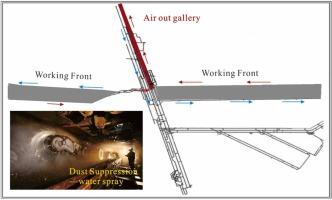Arsenic distribution and speciation in deposited coal mine dust
IF 12.2
1区 环境科学与生态学
Q1 ENGINEERING, ENVIRONMENTAL
引用次数: 0
Abstract
This study investigates arsenic (As) species, sources, and transformation patterns in deposited coal mine dust (DCMD) from three coal mines—QSY, MHJ, and SCC—in the Ningdong Coalfield, China. While the parent coals have low As levels, the DCMD shows significant enrichment, with concentrations 137 to 345 times higher. The mineral composition of the DCMD reflects that of the parent coals but includes secondary minerals such as gypsum and various trace elements, including As. This enrichment results from multiple factors: polluted waters used for dust control in the working front (WF), gangue dust introduced during mining operations, wear from mining machinery affecting Fe levels, and precipitation of As-salts from alkaline mine drainage. In the parent coals, As(V) comprises 60–65 % of the As, while As(III) accounts for 14–35 %. In contrast, the DCMD samples reveal As(V) as the dominant species (22–58 %), with As(III) making up 18–44 %. Arsenic leachability is influenced by Fe content, enhancing As adsorption and limiting mobility in QSY mine, while mixed As complexes in MHJ and SCC under alkaline conditions affect As mobility. The presence of more toxic As(III) in DCMD highlights environmental and health risks, emphasizing the need to avoid high-As polluted waters for dust control.

沉积煤矿粉尘中砷的分布和种类
本研究调查了中国宁东煤田三个煤矿--QSY、MHJ 和 SCC 的沉积煤矿尘(DCMD)中砷(As)的种类、来源和转化模式。虽然母煤中的砷含量较低,但 DCMD 中的砷含量却明显富集,浓度高出 137 至 345 倍。DCMD 的矿物成分反映了母煤的矿物成分,但也包括石膏等次生矿物和包括 As 在内的各种微量元素。这种富集是由多种因素造成的:用于工作面(WF)粉尘控制的污染水、采矿作业期间引入的煤矸石粉尘、影响铁含量的采矿机械磨损以及碱性矿井排水中的砷盐沉淀。在母煤中,As(V)占 60-65%,As(III)占 14-35%。相比之下,DCMD 样品显示 As(V) 是主要种类(22-58%),As(III) 占 18-44%。砷的浸出性受铁含量的影响,在 QSY 矿中,铁会增强砷的吸附性并限制其流动性,而在碱性条件下,MHJ 和 SCC 中的混合砷络合物会影响砷的流动性。DCMD 中存在毒性更强的 As(III),凸显了环境和健康风险,强调了在粉尘控制中避免高砷污染水域的必要性。
本文章由计算机程序翻译,如有差异,请以英文原文为准。
求助全文
约1分钟内获得全文
求助全文
来源期刊

Journal of Hazardous Materials
工程技术-工程:环境
CiteScore
25.40
自引率
5.90%
发文量
3059
审稿时长
58 days
期刊介绍:
The Journal of Hazardous Materials serves as a global platform for promoting cutting-edge research in the field of Environmental Science and Engineering. Our publication features a wide range of articles, including full-length research papers, review articles, and perspectives, with the aim of enhancing our understanding of the dangers and risks associated with various materials concerning public health and the environment. It is important to note that the term "environmental contaminants" refers specifically to substances that pose hazardous effects through contamination, while excluding those that do not have such impacts on the environment or human health. Moreover, we emphasize the distinction between wastes and hazardous materials in order to provide further clarity on the scope of the journal. We have a keen interest in exploring specific compounds and microbial agents that have adverse effects on the environment.
 求助内容:
求助内容: 应助结果提醒方式:
应助结果提醒方式:


